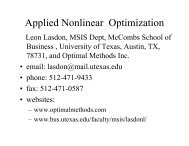[PDF] ALIO Back Matter
[PDF] ALIO Back Matter
[PDF] ALIO Back Matter
Create successful ePaper yourself
Turn your PDF publications into a flip-book with our unique Google optimized e-Paper software.
SB01<br />
3 - On Some Representation Mathematical Models for the Simple<br />
Assembly Line Balancing Problem<br />
Fernando Marval, Universidad de Oriente Núcleo de Sucre, Av.<br />
Universidad Cerro Colorado, Cumaná, 6101, Venezuela,<br />
fmarval@sucre.udo.edu.ve<br />
The purpose of this work is to show some mathematical models which represent the<br />
simple assembly line balancing problem (SALBP). From this SALBP are always<br />
derived two kinds of problem, type-I and type-II problem, depending on the fixed<br />
parameter.<br />
4 - Model of Planning of the Labor Capacities<br />
Òscar Mayorga Torres, Ingeniero, Universidad Libre de Colombia -<br />
Universidad Manuela Beltrán, Calle 8 A No 5-80, Av. Circunvalar<br />
No 60-00, Bogotá, Cu, 0306, Colombia, omt1974@yahoo.com,<br />
Leila Nayibe Ramírez Castañeda<br />
This article presents the theoretical model to determine the planning of the labor<br />
capacities in productive organizations; the model generates information to establish<br />
bottleneck, extension of the capacity programmed and indicating the efficiency and<br />
effectiveness of the organization in terms of productivity and cost.<br />
Sunday, 11:45am - 1:15pm<br />
■ SB01<br />
Aula Magna- First Floor<br />
Tutorial: OR Challenges Arising from Solving<br />
Industrial Applications<br />
Cluster: Tutorials<br />
Invited Session<br />
Chair: Mikael Rönnqvist, Professor, Norwegian School of Economics and<br />
Business, Helleveien 30, Bergen, 5045, Norway,<br />
mikael.ronnqvist@nhh.no<br />
1 - OR Challenges Arising from Solving Industrial Applications<br />
Mikael Rönnqvist, Professor, Norwegian School of Economics and<br />
Business, Helleveien 30, Bergen, 5045, Norway,<br />
mikael.ronnqvist@nhh.no<br />
When implementing decision support systems in practice there is often a number of<br />
special aspects and requirements that must be considered. Many of these can be<br />
very challenging from an OR perspective and/or are counterproductive or nonlogical<br />
for optimality. In this tutorial, we will describe and discuss a number of such<br />
industrial examples. We discuss the reasons behind the requirements, the OR<br />
challenge, how they were approached and implemented, and the results and<br />
general experiences made. The applications cover operational and real time<br />
applications for several areas including routing, inventory and process control.<br />
■ SB02<br />
Aula 360- Third Floor<br />
OR/MS Applications to Humanitarian Logistics<br />
Cluster: OR/MS For Disaster Management<br />
Invited Session<br />
Chair: Luk N. Van Wassenhove, Professor, INSEAD, Technology<br />
Management, Blvd de Constance, Fontainebleau Cedex, 77305, France,<br />
luk.van-wassenhove@insead.edu<br />
Co-Chair: Alfonso J. Pedraza Martínez, PhD Candidate, INSEAD,<br />
Boulevard de Constance, Fointanebleau Cedex, 77300, France,<br />
alfonso.pedrazamartinez@insead.edu<br />
1 - Incentives in Humanitarian Fleet Management<br />
Alfonso J. Pedraza Martínez, PhD Candidate, INSEAD,<br />
Boulevard de Constance, Fointanebleau Cedex, 77300, France,<br />
alfonso.pedrazamartinez@insead.edu, Sameer Hasija,<br />
Luk N. Van Wassenhove<br />
We study incentives in humanitarian last mile fleet management. Typically,<br />
international humanitarian organizations are managed from headquarters in<br />
developed countries. Headquarters recommend policies to national offices, the ones<br />
implementing aid programs. Our extensive field research shows that often<br />
headquarters policies are not followed by national offices, creating system<br />
inefficiencies. We show that aligning incentives imposes challenges that are unique<br />
to humanitarian operations.<br />
<strong>ALIO</strong> / INFORMS International – 2010<br />
28<br />
2 - Emergency Supply Chain Management in the Case of<br />
Epidemics Containment<br />
Thomas K. Dasaklis, PhD Student, Department of Industrial<br />
Management, University of Piraeus, 80 Karaoli & Dimitriou Str.,<br />
Piraeus, 18534, Greece, dasaklis@unipi.gr, Nikos P. Rachaniotis,<br />
Costas P. Pappis<br />
Effective control of an epidemic outbreak calls for the establishment and<br />
management of an emergency supply chain. Resources need to be deployed rapidly<br />
and managed in conjunction with available information and financial resources in<br />
order to contain the epidemic before it reaches uncontrollable proportions. This<br />
paper analyzes relevant logistics operations, reviews OR/MS literature on emergency<br />
supply chain management for epidemics control and pinpoints existing gaps.<br />
3 - Location of Warehouses in Disaster Relief Operations Planning<br />
Stefan Rath, University of Vienna, Bruenner Strafle 72, Vienna,<br />
1210, Austria, Stefan.Rath@univie.ac.at, Walter Gutjahr<br />
The problem studied occurs in the context of operations planning by international<br />
aid organizations in response to natural disasters. A supply system for medium term<br />
disaster relief has to be established. Warehouse locations and delivery tours are to be<br />
determined. We use a three-objective optimization model, with economic and<br />
humanitarian objective functions. As solution method, we propose a math-heuristic,<br />
based on a MILP formulation and iteratively added constraints.<br />
4 - Modeling Seasonality and Strain Mutation in a Pandemic Influenza<br />
Julie Swann, Professor, Co-Director of Humanitarian Logistics, SCL,<br />
Georgia Institute of Technology, Atlanta, GA, United States of<br />
America, jswann@isye.gatech.edu, Pengyi Shi, Pinar Keskinocak,<br />
Bruce Lee<br />
Multiple waves of attack in a pandemic influenza has been observed in the past. We<br />
investigated the reasons of such multi-attacks by modeling two potential factors:<br />
seasonal change and strain mutation. Based on a spatial-temporal disease spread<br />
model incorporated with the two factors, our simulation showed that multiple<br />
attacks may happen under the joint effect of seasonality and mutation. We<br />
reproduced a mortality pattern with 3 peaks similar to the one observed in 1918<br />
and note implications for planning of pandemic response.<br />
■ SB03<br />
Aula 361- Third Floor<br />
Health Care II<br />
Contributed Session<br />
Chair: Luis Hernández, Universidad de los Andes, Bogotá, Colombia,<br />
Calle 100 #49-85 IN 2 AP 402, Bogotá, Colombia,<br />
gabr-her@uniandes.edu.co<br />
1 - Healthcare Systems are Dynamic and Complex Systems:<br />
A New Look through Systems Engineering Methodology<br />
Jean Hosseini, Enterprise Solutions Analyst, Intelekt, 5 Evelen Raod,<br />
Waban, MA, 02468, United States of America, ardint@yahoo.com<br />
Healthcare systems are dynamic and complex social systems. Any dynamic system<br />
that consists of a combination of human behavior, politics, regulations and<br />
automated systems requires application of discipline, methodology and tools of<br />
systems engineering and management sciences. In this paper we will discuss the<br />
tools and concepts of systems engineering and how they can benefit healthcare<br />
systems.<br />
2 - Alternative Signal Criteria in Public Health Surveillance<br />
Saylisse Davila, Arizona State University, 151 E Broadway Rd #210,<br />
Tempe, AZ, 85282, United States of America, saylisse@asu.edu,<br />
George Runger, Eugene Tuv<br />
Public health surveillance collects, analyzes, and interprets public health data to<br />
understand trends and detect changes in disease incidence rates (Thacker, 2000). We<br />
will show that by transforming public health surveillance into a supervised learning<br />
problem we are able to generate a series of simple signal criteria that can aid in the<br />
early detection of an increase in the incidence rate of a disease.<br />
3 - Disease Progression Modeling for Colorectal Cancer<br />
Chaitra Gopalappa, University of South Florida, 4202 E Fowler Ave,<br />
Tampa, FL, United States of America, chaitra@mail.usf.edu<br />
Developing a model to obtain early intervention strategies for colorectal cancer<br />
requires a model of the polyp progression. We present a probability model for<br />
obtaining population-specific progression rates between stages of colorectal polyps,<br />
and present results for rates based on race and family history of colorectal cancer.


![[PDF] ALIO Back Matter](https://img.yumpu.com/17932960/8/500x640/pdf-alio-back-matter.jpg)
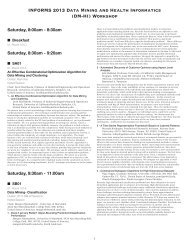
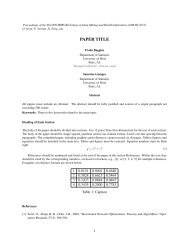
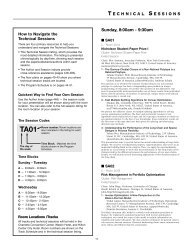
![[PDF] Charlotte Back Matter](https://img.yumpu.com/17933057/1/190x245/pdf-charlotte-back-matter.jpg?quality=85)

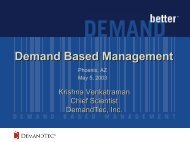
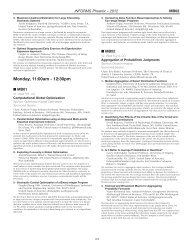

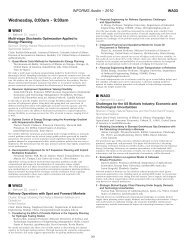
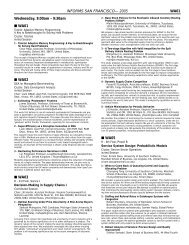
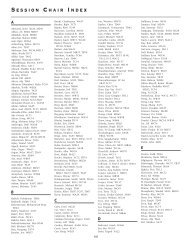
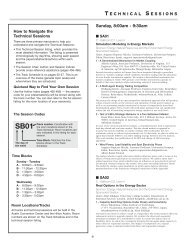
![[PDF] Monday, 8:00am - 9:30am](https://img.yumpu.com/17932954/1/190x245/pdf-monday-800am-930am.jpg?quality=85)
